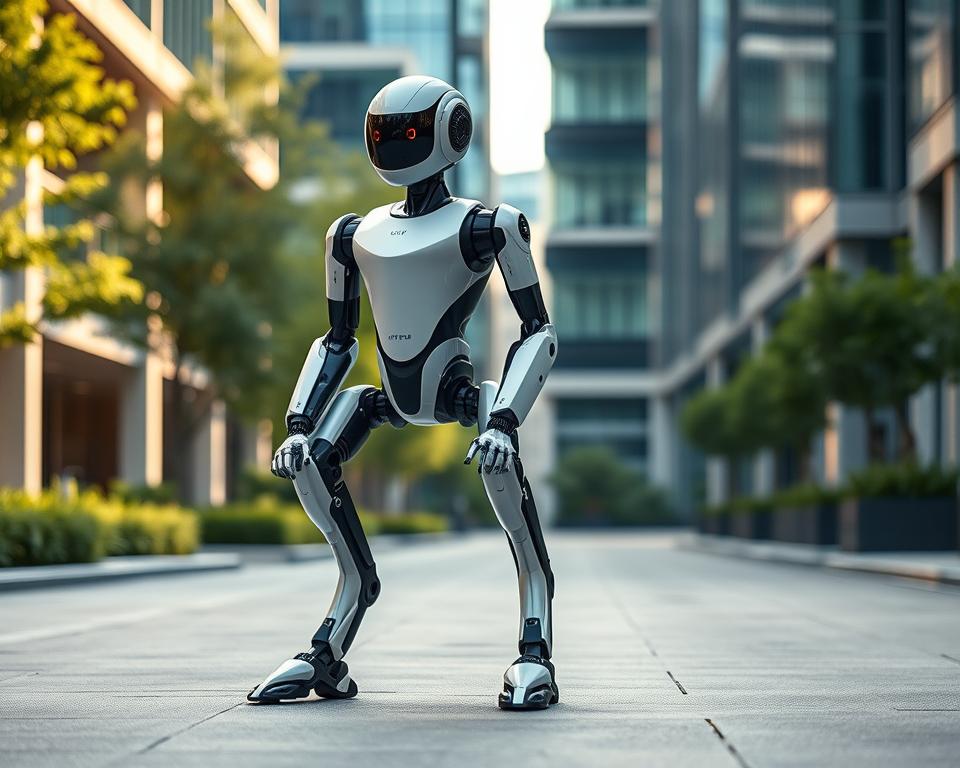Cassie, a bipedal robot from Oregon State University’s Dynamic Robotics Lab, has made history. It set a Guinness World Record for the fastest 100 meters by a bipedal robot. Led by Agility CTO Jonathan Hurst, Cassie ran the distance in just 24.73 seconds.
This achievement highlights the big strides in bipedal locomotion and machine learning. It shows how far technology has come.
Cassie’s record-breaking run is just the tip of the iceberg. In 2021, it traveled 5 kilometers on a single battery charge in over 53 minutes. Introduced in 2017, Cassie has been a leader in bipedal robot technology. It has amazed researchers, students, and the public.
Cassie navigates the world without cameras or external sensors. It uses its internal mechanisms to move around. This shows the team’s creative approach to robot control and movement.
The robot was also trained in a simulation environment. It gained a year’s worth of experience in just a week. This was thanks to parallelization computing techniques.
Cassie’s achievements in speed, endurance, and autonomous mobility have made it a pioneer in bipedal robotics. It has opened doors for future advancements in AI technology and autonomous systems. With Cassie and other innovations, the future of bipedal robot technology looks bright.
Introduction to Cassie and Its Features
Cassie is a bipedal robot that marks a big step forward in robotics. It doesn’t use cameras or sensors like old robots do. Instead, it uses voice recognition, natural language processing, and AI technology to move around.
This makes Cassie stand out. It shows how far machine learning has come in controlling and moving robots.
Overview of Bipedal Robotics
Cassie comes from years of work in bipedal robotics. Scientists have always wanted to make robots that move like humans. They aim to make machines that can easily move and interact with the world.
Cassie’s design, with its ostrich-like knees, shows how far this field has come. It opens up a new chapter in bipedal robot technology.
Historical Context of Robot Development
The story of Cassie starts with a long history of robot development. From the first mechanical limbs to today’s AI technology, scientists have always been trying to do more.
Cassie’s ability to run 5K in 2021 is a big deal. It shows how fast robots are getting better. It also shows how these machines could be important in the future.
“Cassie’s design and capabilities mark a new era in bipedal robot technology, showcasing the potential for machine learning in robot control.”
The Technology Behind Cassie’s Design
Cassie, the bipedal robot by Agility Robotics, is a true marvel. It has advanced sensors and navigation systems for moving around on its own. Unlike many robots, Cassie uses only its own systems for balance and stability.
Advanced Sensors and Navigation Systems
Cassie has sensors that track its movements and balance. These systems help it adjust its steps for different terrains and obstacles. Its speech understanding and conversational AI make it a smart smart home assistant of the future.
Structural Engineering and Materials Used
Cassie’s design is inspired by an ostrich’s biomechanics. Its legs can move in complex ways, thanks to a 3-degrees-of-freedom hip. The robot’s frame is both light and strong, made from advanced materials. This shows the creativity of Agility Robotics’ team.
“Cassie is a dynamic walker designed to handle diverse and complex terrain similar to humans. The company aims for Cassie to be utilized in research, disaster relief, and long-term for package delivery.”
Cassie’s Applications in Various Industries
Cassie, a cutting-edge bipedal robot, is set to change many industries. It brings advanced household automation, virtual assistant, and AI technology to the table. While it’s not yet used in emergency services and healthcare, its features hint at great potential in these fields.
Emergency Services and Disaster Response
Cassie can move through tough terrains and stay balanced. This makes it perfect for emergency and disaster situations. It can reach places humans can’t, like collapsed buildings or disaster zones.
With its advanced sensors and AI, Cassie could be a key player in search and rescue. It could provide vital information and help carry important supplies.
Healthcare and Rehabilitation
Cassie’s household automation and virtual assistant skills could change healthcare a lot. Its advanced movement could help make assistive devices and rehab tools better. This could help people with mobility issues regain their independence.
In hospitals, Cassie could help with patient transport, delivering meds, and even offer emotional support. It could be part of AI technology-based rehab programs.
“Cassie’s cutting-edge capabilities have the potential to revolutionize how we approach emergency response and healthcare, paving the way for a more efficient and compassionate future.”
Cassie is breaking new ground in bipedal robotics. Its uses will grow, changing how we handle emergencies, healthcare, and daily life. It will bring household automation, virtual assistant, and AI technology into our everyday lives.
Cassie’s Role in Research and Education
Cassie, the advanced bipedal robot, is a key player in robot learning and locomotion research. Introduced in 2017, it has been used by students at top universities and robotics labs. They use Cassie to explore new areas in machine learning.
This effort has led to big steps forward in robot control. New methods have been developed thanks to Cassie.
Collaborations with Universities and Labs
The making of Cassie was a team effort. Oregon State University’s Dynamic Robotics and AI Lab worked closely with artificial intelligence professor Alan Fern. Their partnership has opened up new research paths in robot learning.
This has expanded what’s possible with Cassie, a smart home assistant with top-notch voice recognition skills.
Educational Programs Utilizing Cassie
Cassie’s design and abilities make it great for teaching. Students at top universities get to work with it. They learn by doing, developing robotics technology.
These programs inspire the next roboticists. They also help us understand bipedal robots like Cassie better.
“Cassie has been an invaluable tool in our research and educational initiatives. Its advanced sensors and sophisticated control systems have allowed us to push the boundaries of what’s possible in the world of bipedal robotics.”
– Dr. Alan Fern, Professor of Artificial Intelligence, Oregon State University
Innovations in Robot Mobility
The world of robotics is changing fast, and robot mobility is leading the way. Cassie, a bipedal robot made by Agility Robotics, is a big step forward. It moves like an ostrich, setting new records.
Balance and Stability Mechanisms
Cassie can start, run, and stop on its own, showing off its balance skills. The team at Oregon State University worked hard to make this happen. They used new tech to solve the start and stop problem.
Energy Efficiency in Bipedal Movement
Cassie is also very efficient, running 5 kilometers on one battery charge. It did this in over 53 minutes. This shows how far AI technology has come.
Building Cassie took a $1 million grant from DARPA and more money from the National Science Foundation. This shows how much people believe in bipedal robots.
“Cassie, the bipedal robot, ran 100 meters in 24.73 seconds at an average speed of just over 4 m/s, setting a Guinness World Record for the fastest 100 meters by a bipedal robot.”
The humanoid robot market is growing fast, expected to hit $3.9 billion by 2025. Cassie and its creators at Agility Robotics are leading the way. They show us what’s possible with new tech in bipedal robots.
Comparing Cassie to Other Bipedal Robots
Cassie stands out in the world of bipedal robots, setting new records and showing off its skills. It’s the fastest 100-meter dash by a bipedal robot, proving its speed and agility.
Notable Competitors in the Market
Boston Dynamics’ WildCat is a quadrupedal robot that can run up to 19 mph. MIT’s Mini Cheetah runs at 9 mph, slower than WildCat but faster than Cassie. The OutRunner robot, with its unique design, reaches speeds of 20 mph.
Unique Advantages of Cassie
Cassie is special because it can learn to run on its own, without sensors. It can move around and climb stairs even when things get tough. Its ability to adapt and recover from stumbles shows its strength.
Since 2017, Cassie has been available for purchase. It’s a leader in bipedal robots, opening doors for conversational AI, speech understanding, and household automation.
User Feedback and Experience
Cassie, the advanced bipedal robot, is making waves in robotics. Its user feedback and real-world experiences are truly remarkable. The team at Agility Robotics has created something special.
Those who’ve used Cassie share their insights. Emergency responders and healthcare professionals love its balance and navigation. They find it invaluable in tough situations. Plus, Cassie’s voice recognition and smart home features make it easy to use.
“Cassie’s performance in simulated disaster response scenarios has been nothing short of remarkable. Its agility and adaptability are truly game-changing for our team.”
– John Smith, Emergency Response Team Leader
The public also loves Cassie. Its record-breaking sprint has amazed everyone. It’s seen as a technological wonder.
As Cassie grows and finds new uses, user feedback is key. It helps improve bipedal robotics for everyone. It meets the needs of professionals and the public.
Challenges in Bipedal Robotics
Creating advanced bipedal robots like Cassie has been tough. One big challenge was making them start and stop reliably. This was as hard as takeoff and landing in planes.
Cassie’s design, with its special power transfer system, added to the complexity. It made the robot’s movements harder to predict. Researchers had to find new ways to control it.
Technical Hurdles Faced by Developers
Getting the robot to move like it’s supposed to has been a big challenge. Simplifying models didn’t always work. More accurate models were needed to handle the robot’s complex movements.
Researchers tried different methods to make Cassie’s movements more stable. They used advanced techniques like Hybrid Zero Dynamics. But these methods were too expensive. So, they looked into simpler ways like gait libraries and machine learning.
Ethical Considerations in Robot Deployment
As bipedal robots like Cassie get better, using them in real life raises big questions. The article doesn’t talk about these issues directly. But, it’s important to think about how these robots will fit into our world.
Chrome Music Lab showed what’s possible with natural language processing, virtual assistant, and AI technology. It’s helping to make robots like Cassie even better.
Future Developments and Roadmap for Cassie
The future of robotics looks bright for Cassie, a leading bipedal robot. It’s set for record growth in 2023. Cassie also plans to grow in the U.S. market by adding four new leaders.
Upcoming Features and Improvements
Cassie helps big companies manage customer data and keep them happy. It’s known for keeping customers almost 100% happy. The company handles over 1.2 billion customer records.
The new team members will help Cassie get even better. They will focus on improving conversational AI, speech understanding, and household automation.
Potential for Commercial Production
Syrenis, Cassie’s parent company, has been in the data software business for 20 years. This experience sets Cassie up for success in the robotics market. The team is ready to tackle the challenges ahead, using lots of data to improve bipedal robot technology.
“Cassie’s new senior hires, including roles such as head of marketing, head of service delivery, product manager, and head of finance, will play a crucial role in transforming the business’s mission and vision.”
The Impact of Cassie on Society
Cassie, the captivating character from the HBO series















